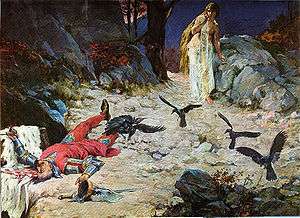Battle of Gvozd Mountain
| Battle of Gvozd Mountain | |||||||
|---|---|---|---|---|---|---|---|
| Part of the War of the Croatian Succession | |||||||
 Death of the Last Croatian King from House of Trpimirović, by Oton Iveković | |||||||
| |||||||
| Belligerents | |||||||
|
|
| ||||||
| Commanders and leaders | |||||||
| Petar Svačić † |
Coloman of Hungary (not present) Mercurius | ||||||
| Strength | |||||||
| unknown | unknown | ||||||
| Casualties and losses | |||||||
| Heavy | Unknown | ||||||
The Battle of Gvozd Mountain took place in the year 1097 and was fought between the army of Petar Svačić and King Coloman I of Hungary. It was a decisive Hungarian victory, which ended the War of the Croatian Succession and served as a turning point in Croatian history.
Battle
In an attempt to win the crown of the Kingdom of Croatia, the Hungarian army crossed the River Drava and invaded Croatian territory, trying to reach the Adriatic coast. A local lord, Petar Svačić, then moved from his residency at Knin castle in an attempt to defend the kingdom from the Hungarians. Peter and his army moved north to meet the advancing Hungarians.
Location
The traditional Croatian historiography identified Gvozd Mountain, the location of the battle according to Gesta Hungarorum, as today's Petrova Gora.[1][3] In the second half of the 20th century, an alternative interpretation emerged, by which the battle took place in the Kapela mountain pass of central Croatia.[1][2] The changes in name of these two locations created confusion; the first was known as Slatska Gora until 1445, and only from 1536 as Petrova Gora, while the second until 1522 was known as Iron Mountain (Alpes ferreae), Gvozd (Gozdia) and Petrov Gvozd (Peturgoz) when due to the chapel of St. Nikola (previously St. Mikula), the population started to call it as Kapela.[1]
Aftermath
The outcome of the battle was disastrous for Petar Svačić's army and country because it marked the official end of a native dynasty ruling in Croatia. The winner of the battle, King Coloman of Hungary created a personal union between the kingdoms of Hungary and Croatia (allegedly signing the Pacta conventa). He was then crowned as King of Croatia in the Croatian capital Biograd on the Adriatic coast in 1102. Until the end of the World War I in 1918, the two crowns were united in personal union.
References
- "Gvozd". Croatian Encyclopedia (in Croatian). Miroslav Krleža Institute of Lexicography. 18 October 2012. Retrieved 22 February 2015.
- Jelaska Marijan, Zdravka (2002). "Dolazak ugarskoga kralja". Hrvatska revija (in Croatian). Matica hrvatska (4). Retrieved 22 February 2015.
- "Petrova gora". Croatian Encyclopedia (in Croatian). Miroslav Krleža Institute of Lexicography. Retrieved 22 February 2015.
External links
![]()


